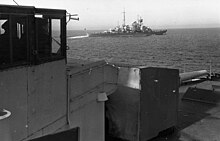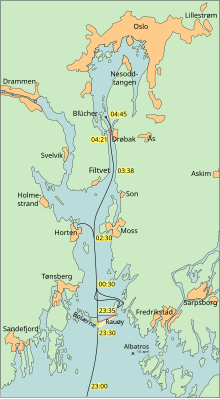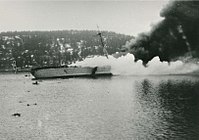Blucher (1939)
The Blücher was the second of five Admiral Hipper-class heavy cruisers of the German Kriegsmarine, built after the rise of the Nazi Party and its rejection of the Treaty of Versailles. Named after Prussian Field Marshal Gebhard Leberecht von Blücher, one of the victors of the Battle of Waterloo, the cruiser began construction in August 1936 and was launched in June 1937. It was completed in September 1939, shortly after of the outbreak of World War II. After sea trials and several training maneuvers, the ship was ready for service with the German fleet on April 5, 1940.
Assigned to Group 5 during the German invasion of Norway in April 1940, the Blücher served as Rear Admiral Oskar Kummetz's flagship. The cruiser led the German flotilla that entered the Oslo Fjord on the night of April 8 to seize Oslo, the capital of Norway, but two old coast guns from the Oscarsborg fortress fired at the ship at very close range and killed it. They caused two hits. Two torpedoes launched from land batteries also hit her and caused a large fire on board the Blücher that could not be controlled. Following an explosion in her ammunition stores, the ship slowly listed and sank, with the loss of many lives. Her wreck remains at the bottom of the Oslo Fjord.
Construction

The Kriegsmarine commissioned the construction of the Blücher to the Deutsche Werke shipyard in Kiel. Her keel was laid down on August 15, 1936 with construction number 246 and the launch was held on June 8, 1937. It was not completed until two years later, on September 20, 1939, the day it entered service in the German fleet. Recently built, the cruiser had a straight bow, although after its launch this was replaced by a more curved stem that increased its overall length to 205.9 m. A cover for the chimney was also installed.
At launch the Blücher had an overall length of 202.8 m, a beam of 22 m and a maximum draft of 7.74. The cruiser had a design displacement of 16,170 tons, which It reached 18,200 fully loaded. She was powered by three geared steam turbines that received steam supply from twelve high-pressure liquid fuel boilers. Her maximum speed was 32 knots (59 km/h) thanks to her 132,000 hp (98,000 kW).According to her design, her standard crew was 42 officers and 1,340 sailors.
The main armament of the Blücher consisted of eight 203 mm L/60 SK guns mounted in four twin turrets, arranged in pairs forward and aft. Its anti-aircraft battery consisted of twelve 105mm L/65 guns, twelve 37mm guns, and eight 20mm guns. It also had a pair of triple torpedo tubes alongside the rear superstructure. The cruiser was equipped with three Arado Ar 196 seaplanes and a catapult for launching. Blücher's armor belt was between 70 and 80 mm thick and its upper deck was between 12 and 30 mm thick. armor, while the main protective cover was 20 to 50 mm. The turrets of the main batteries had 105 mm in front and rear and 70 mm on both sides.
Service History

Further fitting out and improvements to Blücher were carried out during most of November 1939. Towards the end of the month she was ready for sea trials, for which she sailed to Gotenhafen in the Baltic Sea. The tests lasted until mid-December, after which the cruiser returned to Kiel for final modifications. In January 1940 she returned to carry out maneuvers in the Baltic, but in the middle of the month ice forced her to remain in port. On 5 April her ship was deemed ready for action, so she was consequently assigned to the forces tasked with the invasion of Norway.
Operation Weserübung

On April 5, 1940, Rear Admiral Oskar Kummetz and an 800-strong detachment of ground troops from the 163rd Infantry Division of the German Army embarked on the Blücher in the port of Swinemünde. German army. Three days later, on April 8, the cruiser left for Norway as the flagship of the force that was to take Oslo, the capital of the Nordic country. The Blücher was part of Group 5 of the invasion force, also composed of the heavy cruiser Lützow and the light cruiser Emden, as well as other escort ships. While the squadron was sailing through the Kattegat and Skagerrak straits, the British submarine Triton sighted the convoy and fired a salvo of torpedoes at it to no avail.
Night had fallen when the German flotilla reached the entrance to the Oslo Fjord. Shortly after 23:00—Norwegian time—the German force was sighted by the Norwegian patrol vessel Pol III. The German torpedo boat Albatros attacked it and set it on fire, but not before the patrol boat became alarmed about the attack by some unknown ships. At 23:30 the southern battery of Rauøy sighted the flotilla with its searchlight and fired two warning cannon shots. Five minutes later he fired four more at the German ships, but poor visibility prevented him from hitting any of them. Bolærne's guns fired a single howitzer at 23:32, but before The Blücher could be hit disappeared from his shooting range.

The German flotilla was sailing at a speed of 12 knots (22 km/h). Shortly after midnight Norwegian Public Radio, the Norsk Rikskringkasting, broadcast an order from the commanding admiral to shut down all lighthouses and navigation lights. The German ships had been ordered to open fire only in case they were attacked. Between 00:30 and 02:00 the flotilla stopped and 150 soldiers from the landing forces were transferred to escorts R17 and R21 from Emden and R18 and R19 from the Blücher.
The R-boat minesweepers were to attack Rauøy, Bolærne and the port and town of Horten. Despite the apparent loss of surprise, the Blücher proceeded to advance into the fjord to meet with what was planned and arriving in Oslo at dawn. At 04:40 the Norwegian searchlights again illuminated the cruiser, and forty minutes later the 280 mm coastal guns located in the Oscarsborg Fortress opened fire on the Blücher, thus beginning the battle. of the Drøbak Strait. The shore guns landed several hits very close to the port side of the German ship. The first was well above the bridge, hitting the anti-aircraft gun commander's position and killing Lieutenant Hans-Erich Pochhammer. The rangefinder main rangefinder at the top of the battle tower was misaligned, although the Blücher had three other large rangefinders - in turrets B and C and on the bridge -, other smaller ones on the bridge and the four rangefinders for anti-aircraft guns. The D turret commander, chief gunner Waldeck, stated that this first 280 mm hit had no influence on the performance of the 203 mm batteries during combat.
Fire
The second 280 mm impact caused more serious damage: it hit near the aircraft hangar, caused a large fire and detonated the infantry's explosives, which made efforts to extinguish them difficult. The explosion set fire to the two Arado seaplanes, one of which was on the take-off catapult and the other in its hangar. The explosion probably also blew a hole in the armored deck above the turbine room. Turbine 1 and the generator in room 3 stopped and only the side propellers remained running.
The Germans were unable to identify the source of the cannon fire, so the Blücher increased its speed to 32 knots (59 km/h) in an effort to outrun the Norwegian guns. The 150 mm guns at Drøbak, about 370 meters to the starboard side of the Blücher, also opened fire. The chief engineer, Commander Karl Thannemann, wrote in his report that the impacts of the Drøbak's guns, fired from the starboard side, all hit between sections IV and

The Blücher had just passed the Drøbak Strait and was in full turn to port when damage caused by the gunfire from Drøbak's 150 mm batteries caused the bridge to lose control of the rudder. The commander regained course using the side propellers, but the ship lost speed. The rudder was normally electrically controlled from the bridge, but there was also a manual steering room under the armored deck, just forward of the rudder. In an emergency it could be quickly switched to manual control, but electrical damage made communication between the bridge and manual rudder control difficult. At 05:30, Norwegian shore-based torpedo batteries made two hits on the German cruiser, and this despite the fact that its shooting device was very primitive and the speed of the target had to be established by estimation.
According to Admiral Kummetz's report, the first torpedo hit boiler 2, just below the chimney, and the second in the room of turbines 2 and 3 that drove the side propellers. Boiler 1 had already been destroyed by cannon fire, and only one boiler remained, but all steam pipes through boilers 1 and 2 and turbine room 2/3 were damaged and the turbine for the main propeller lost its power. force. Around 05:34 the ship was seriously damaged, but it had managed to pass through the most exposed area and the Norwegian weapons could no longer target it. However, the cruiser's rudder had become stuck on the port side and the propeller on that side had to be stopped and the starboard propeller put in reverse at maximum speed so that the ship could maintain a straight course.
Sinking
After leaving the coastal batteries behind, the crew of the Blücher, including the turret crew, attempted to put out the fire. By then the cruiser was suffering a list of 18°, although this was not problematic at first. However, the fire reached the ammunition store of one of the 105 mm guns and caused a violent explosion that broke several bulkheads in the engine room and ignited the ship's fuel tanks. The battered cruiser slowly began to list and The order was given to abandon ship. The Blücher rolled over and sank at 07:30 with great loss of life. Naval historian Erich Gröner stated that the death toll was unknown, but Henrik Lunde gives the figure of one thousand dead among soldiers and crew. Jürgen Rohwer, for his part, states that 125 sailors and 195 soldiers died in the sinking.
The loss of the heavy cruiser Blücher and the damage to the Lützow forced the Germans to withdraw. The infantry landed on the east bank of the fjord and proceeded on their mission by land. They took the fortress of Oscarborg at 09:00 on April 10 and then moved on to attack the capital, Oslo. The airborne troops took the Fornebu airport and completed the encirclement of the city, which by 14:00 on the 10th was in German hands. However, the delay caused by the temporary withdrawal of the Blücher task force gave time for the Norwegian government and royal family to flee the city.

The wreck of the Blücher rests at the bottom of the Oslo Fjord, specifically in the Drøbak Strait, half capsized on its forecastle, at a depth of between 64 m in the highest part and 90 m in its lowest part. The cruiser's propellers were recovered in 1953, and although it has been proposed on several occasions since 1963 to salvage the wreck, this has not yet been done. When the Blücher left Germany with 2,670 cubic meters of fuel on board. She spent some on the trip to Norway, and some was also lost in the sinking, but she pours fuel constantly. In 1991 the amount of leaks increased to fifty liters per day, an environmental threat, so the Norwegian Government decided to recover as much oil as possible from the wreck. In October 1994, several divers from the Rockwater AS company drilled holes in 133 fuel tanks and removed a thousand tons of hydrocarbons. Forty-seven fuel tanks could not be reached and are still full. After carrying out the cleaning process, the oil was sold. This extractive process gave the opportunity to recover one of the two Arado Ar 196 seaplanes from the German cruiser, which was raised on November 9, 1994 and is currently on display at the Flyhistorisk Museum, the aviation museum in Sola, near Stavanger..


